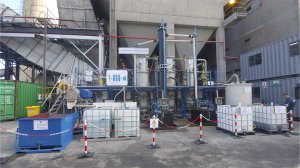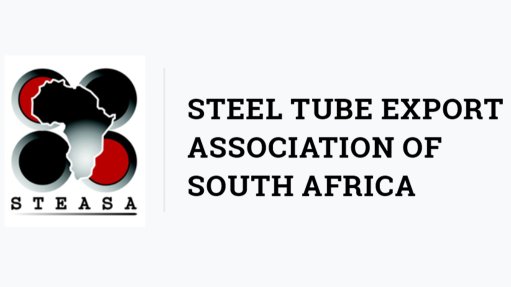Companies unveil Kelvin power station carbon capture pilot project
The 600 MW coal-fired Kelvin power station, in Isando, Ekurhuleni, has installed a 300 m3/h flue gas emissions capturing pilot project, which removes carbon dioxide (CO₂), nitrogen oxides and sulphur oxides to make sulphuric acid, ammonium sulphate and ammonium bicarbonate (ABC) crystals.
These are industrial products, which can be used as industry inputs and to make fertiliser. Specialist industrial and agricultural chemicals company Omnia has developed a marketable fertiliser formulation using converted inorganic salts from the plant, which it demonstrated at the site on March 20.
The multi-pollutant abatement project is a collaboration between the Department of Science and Innovation (DSI) under its Hydrogen Society Roadmap, German development agency GIZ, biotechnology institute Fraunhofer IGB, South African management consulting services firm EPCM Global Engineering and German industrial gases cleaning company Carbon Process & Plant Engineering (CPPE).
The CoalCO₂-X programme is aimed at harnessing the components of the flue gas for the circular production of products such as diesel and fertilisers, as well as to convert CO₂ from South African coal-fired power plants using ammonia and hydrogen, and eventually using green ammonia and green hydrogen.
The entire plant is post-precipitation, meaning it comes after the power plant's industrial processes are complete. The process is continuous and can be scaled up to hundreds of thousands of cubic meters an hour, EPCM Global Engineering CEO Tumi Kgomo explained during a site visit to the plant.
The flue gases are first extracted into a quenching system to lower the temperature and water is added to maximise the humidity, while heavy metals and any remaining particulate matter are also removed at this stage.
The flue gases are then sent on to the sulphur oxides reactor, where the sulphur oxides are removed and sulphuric acid produced using water. The gases then enter a cooling stack.
Flue gases are sent on to the CO₂ reactor, which uses ammonia to remove the CO₂ and produce ABC crystals. These can be used as a fertiliser base.
From here, the remaining flue gases continue to the ammonia reactor where sulphuric acid is used and ammonium sulphate produced.
The final part of the process is the nitrogen oxides reactor that removes these gases, and the cleaned gases are then released.
The output readings Engineering News saw on March 20 during the demonstration was that sulphur oxides were reduced from 259 parts per million (ppm) in the flue gases to 0 ppm, and nitrogen oxides were reduced from 459.5 ppm to 0.2 ppm.
CO₂ was reduced from 7.76% of the gases to 5.62%. The concentration of CO₂ in the Kelvin power station's flue gases varies between about 7% and 10% of volume.
However, hard-to-abate industrial processes that liberate more CO₂ than they do for primary energy consumption, such as cement making, have higher percentages of about 15% to 25% CO₂ in their flue gases and a greater proportion of the gas can be captured, Kgomo said.
The pilot plant is aimed at achieving a 50% reduction in CO₂, but the partners say the final process should be capable of removing 90% of the gas.
The main aim of the multi-pollutant abatement pilot plant was to help power stations to meet emissions targets, as well as to give them sufficient capacity to meet higher emissions standards in the future, said Kgomo.
"The plant fundamentally shifts the opportunities for functional compliance that is not a sunk cost. The break-even point for the plant is about five to seven years," he noted.
Meanwhile, the Kelvin power station, which is an independent power producer selling mainly to the City of Johannesburg, has researched various technologies and concluded through a study that a hydrogen-ready natural gas power station was the most feasible on the current site, said Kelvin Power GM Oupa Seopa.
"We have access to the grid and a natural gas pipeline, the site is zoned for generation, and is well suited for baseload gas to power generation.
"The US economy managed to reduce emissions by about one-third, but also grew its economy by using natural gas. A natural gas power station can contribute to the economy while reducing greenhouse gas emissions," he said.
Natural gas can be part of a measured path to decarbonisation and can provide grid stability and replace coal-fired power stations.
"We have embraced the partnership with EPCM, as it is a step in the right direction to net-zero. If the pilot plant's outcome is successful, we will integrate it into our new power plant," he said.
Further, the power producer expressed hope that EPCM and the DSI would keep the pilot programme at the power plant and prove the technology to support decision-making surrounding future power plants as well.
"We hope to assist other hard-to-abate industries and coal-fired power stations that want to move towards net zero. The just energy transition will need security of supply to work, or the lack could lead to a backlash and hold back the transition," Seopa said.
Part of the research funded by Germany in the project focuses on piloting renewable ammonia synthesis on the 1 kg/h scale in a low-pressure Haber Bosch reactor using electrolytic hydrogen produced by Hydrogen South Africa.
The renewable hydrogen and ammonia is a link of key importance between the technologies developed within the programme.
Article Enquiry
Email Article
Save Article
Feedback
To advertise email advertising@creamermedia.co.za or click here
Comments
Press Office
Announcements
What's On
Subscribe to improve your user experience...
Option 1 (equivalent of R125 a month):
Receive a weekly copy of Creamer Media's Engineering News & Mining Weekly magazine
(print copy for those in South Africa and e-magazine for those outside of South Africa)
Receive daily email newsletters
Access to full search results
Access archive of magazine back copies
Access to Projects in Progress
Access to ONE Research Report of your choice in PDF format
Option 2 (equivalent of R375 a month):
All benefits from Option 1
PLUS
Access to Creamer Media's Research Channel Africa for ALL Research Reports, in PDF format, on various industrial and mining sectors
including Electricity; Water; Energy Transition; Hydrogen; Roads, Rail and Ports; Coal; Gold; Platinum; Battery Metals; etc.
Already a subscriber?
Forgotten your password?
Receive weekly copy of Creamer Media's Engineering News & Mining Weekly magazine (print copy for those in South Africa and e-magazine for those outside of South Africa)
➕
Recieve daily email newsletters
➕
Access to full search results
➕
Access archive of magazine back copies
➕
Access to Projects in Progress
➕
Access to ONE Research Report of your choice in PDF format
RESEARCH CHANNEL AFRICA
R4500 (equivalent of R375 a month)
SUBSCRIBEAll benefits from Option 1
➕
Access to Creamer Media's Research Channel Africa for ALL Research Reports on various industrial and mining sectors, in PDF format, including on:
Electricity
➕
Water
➕
Energy Transition
➕
Hydrogen
➕
Roads, Rail and Ports
➕
Coal
➕
Gold
➕
Platinum
➕
Battery Metals
➕
etc.
Receive all benefits from Option 1 or Option 2 delivered to numerous people at your company
➕
Multiple User names and Passwords for simultaneous log-ins
➕
Intranet integration access to all in your organisation

















